1. Australian fund managers short Tesla and Elon Musk
When Elon Musk dramatically promised to build a grid-scale battery in South Australia, the media was enthralled. Share traders and a string of Australian fund managers smirked. They’d seen it all before, and were shorting him in the market.
In that very week he was in the market with plans to raise $US1.15 billion in equity and convertible notes. I understand also that Tesla has gone strangely quiet about SA since then.
-
“I think it was classic Musk,” says Regal Funds Management senior analyst Omkar Joshi. “That’s what he does. He goes in and talks things up and capitalises on any situation to promote the brand, himself and the company. And once he runs out of steam, he moves on to the next thing.”
Tesla’s share price in on 56 times 2020 earnings, pitched at an optimistic $US26 billion annual revenue, which requires explosive growth. By contrast our pedestrian Woolworths has revenue of $A48 billion, and Wesfarmers, owners of Coles, Target, Kmart Officeworks, Bunnings and a couple of coal mines, has $A58 billion worth of revenue.
Someone was unkind enough to point out that Tesla isn’t the biggest maker of electric cars.
2. State of the climate
The World Meteorological Organization has issued its State of the Global Climate 2016. Extreme weather has continued, records were broken, most notably in global surface temperature:
- “This report confirms that the year 2016 was the warmest on record – a remarkable 1.1 °C above the pre-industrial period, which is 0.06 °C above the previous record set in 2015. This increase in global temperature is consistent with other changes occurring in the climate system,” said WMO Secretary-General Petteri Taalas.
The report is appropriately summarised in the Sacramento Bee as the climate is in ‘uncharted territory’. At this point I’ll just post two graphs:
First emissions (CO2, methane and nitrous oxide) are actually accelerating:
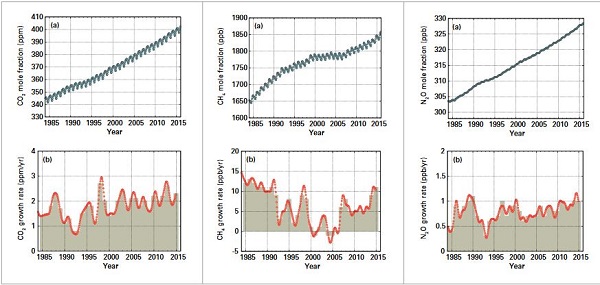
Remember this next time you hear emissions are flatlining. It’s what ends up in the atmosphere that counts.
Then they have a rainfall map of Australia:
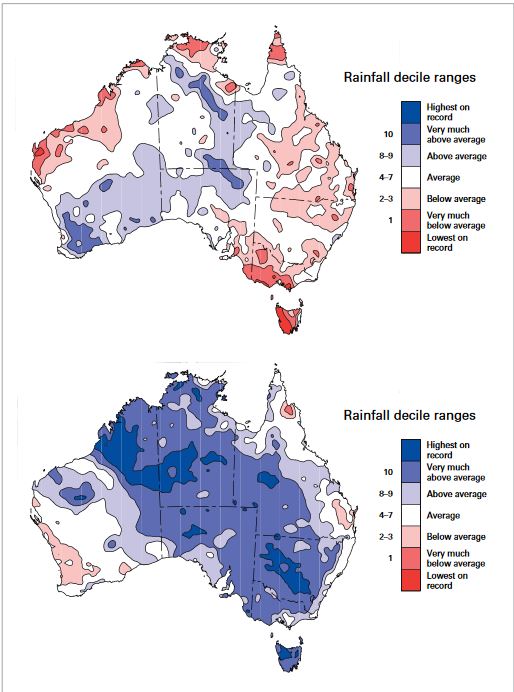
The top one is September 2015 to April 2016, and the bottom May to December 2016. What happened is that the El Niño weakened and the Indian Ocean dipole produced warmer oceans to our west. The two maps are classic examples of the effects of both ocean systems.
3. East African famine
According to the New Scientist of 17 March, East Africa faces famine (paywalled), in part because of the Indian Ocean Dipole:
- According to the UN Environment Programme, 17 million people in the region now face hunger. “We are currently facing potentially the worst humanitarian disaster the world has known since 1945,” says Mike Noyes at the charity ActionAid.
Furthermore:
The famine is the third to hit the region in 25 years. The last, in 2011, resulted in 260,000 deaths.
The dipole has been getting more pronounced in recent years, and extreme climate events such as drought are projected to become more common as the world warms.
4. Methane Erupting From Arctic Ocean Seafloor
Thanks to BilB for the link.
Methane clathrates in the Arctic are erupting in concentrated plumes, which are missed by measuring stations and satellites. From the troposphere they spread to the equator, where the methane is wrongly assumed to come from tropical wetlands. This image showed a profile of the circulation systems.
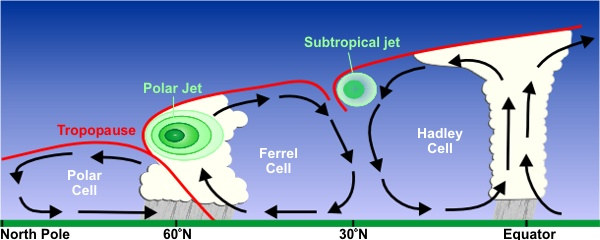
5. Plankton can save the ocean, but who will save the plankton?
According to the New Scientist (paywalled) oxygen levels in the oceans have dropped by 2 per cent in the last half century and are projected to fall by a further 7 per cent by 21000.
It’s all very complex, but phytoplankton seem to be the problem. They produce nearly half the oxygen in the atmosphere through photosynthesis, more than all the forests on land. Phytoplankton are at the base of the food chain in our seas.
A large part of the problem seems to be our destruction of the topline species in the food chain. Their poo is consumed by the phytoplankton. Also whales stir up the water, bringing nutrients from the deep.
Suggested solutions all have problems. some have suggested pipes and pumps to bring up water from the deep. Doesn’t sound practical at any scale to me, but cooler water actually absorbs more CO2 increasing acidity.
6. Turnbull government climate policy review
Here’s the discussion paper the Turnbull Government has put out for its review of climate policies, which will not be finished before the end of the year. It’s a catalogue of existing policies and provisions, with questions. It has one useful graph:
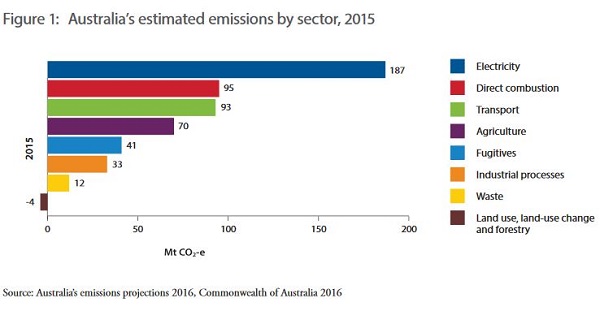
Sophie Vorath raises the question as to whether the Government can be taken seriously when three members of the Climate Change Authority have resigned in disgust.
Clive Hamilton left because of the Coalition’s “perverse” and “deeply dishonest” approach to climate and energy policy.
Danny Price left saying the Government “doesn’t take the issue seriously”.
John Quiggin posted on his blog:
- The government’s refusal to accept the advice of its own Authority, despite wide support for that advice from business, environmental groups and the community as a whole, reflects the comprehensive failure of its policies on energy and the environment. These failures can be traced, in large measure, to the fact that the government is beholden to right-wing anti-science activists in its own ranks and in the media. Rather than resist these extremists, the Turnbull government has chosen to treat the vital issues of climate change and energy security as an opportunity for political point scoring and culture war rhetoric.
He said there is nothing useful to be gained in giving informed advice “to a government dominated by elements hostile to both science and economics.”
7. Turnbull policies failing where it matters
The effect of removing the price on carbon is quite clear and dramatic.
- Overall, climate pollution is up by 3.4 per cent since last year and by 7.5 per cent since the Abbott-Turnbull government axed the carbon price.
Unlike the government’s current policy, the carbon price was reducing Australia’s pollution. This is evident in the data.
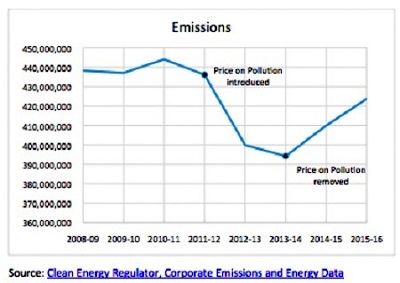
The new data also shows pollution from Australia’s electricity sector, which is responsible for about 35 per cent of our climate pollution, went up 2.6 per cent on the previous year and 5 per cent since the carbon price was removed.
The pollution increases — from specific generators and overall — show there is little incentive for big polluters to clean up their acts when they have a free ride to pollute.
8. World’s biggest solar + battery storage plant ready to build in SA
The world’s biggest solar and battery storage plant – and Australia’s biggest solar farm – could begin construction this year, after the project was formally launched in Adelaide on Thursday.
The developer of the $1 billion South Australian project, Lyon Group, said construction of the plant, which will include 330MW of solar PV and a 100MW/400MWh battery storage system, would begin in the coming months, with operations set to commence by the end of 2017.
I think we are heading down the path of solar plus storage. We’d just do it faster, in a more orderly way, and with better effect if government policy caught up.
9. Trump’s war on climate change
Joe Romm covers Trump’s “sweeping executive order that effectively guts national efforts to address climate change”.
The question now is whether he will exit the UN climate change process which produced the Paris agreement.
I’ve heard it argued that we would be better off if he goes. The UN works on consensus. One vote can form a veto. If the US under Trump stays, he can really mess things up.


Looking at the graph emissions went down during the Gillard minority government was in power and the Greens had influence.
It started going up again as soon as Abbott took over. At the time when the carbon price was removed Abbott was creating uncertainty about the future of the RET, an important driver of renewable investment.
The key factor is government commitment to climate action. The killing of the carbon price is a symptom.
On 9., I think the veto at the UN applies only in the Security Council.
Ambigulous, at the Security Council the major powers have a veto. Not sure what goes in the General Assembly.
I know that in the climate body, the UNFCCC, votes require consensus of all members at the annual Conference of Parties. That’s why the Paris agreement allows members to formulate and submit their own targets. “Common but differentiates responsibility” is the phrase.
Actually, at theCancún COP in 2010 the major decision was whether to adopt 2 °C global warming as a goal. Bolivia never agreed, arguing for a lower figure. Nevertheless Patricia Espinosa, the Mexican chair, brought down her gavel and declared the resolution passed, ignoring Bolivia’s protests.
No chair would have done that if the dissenter had been the USA.
Nevertheless, the decision allowed the progress which gave us the Paris agreement five years later, to be implemented from 2020. Thus the UN wheels grind slowly. However, between now and then they will be writing the accountability rules.
If the US dips out now they may get rules which they don’t like which a future US president will have to take or leave if they want to rejoin. One way or another Trump will do long term damage.
BTW the WTO also works on consensus rules, which I think is why they don’t meet anymore. In Cancún in 2003 the developing countries wouldn’t cop it any more, so the trade thing has moved to bilateral and regional agreements.